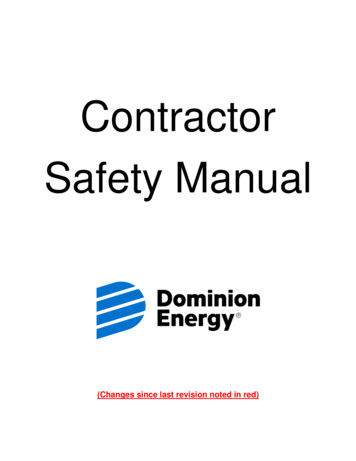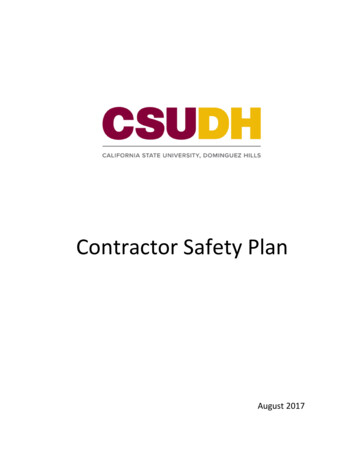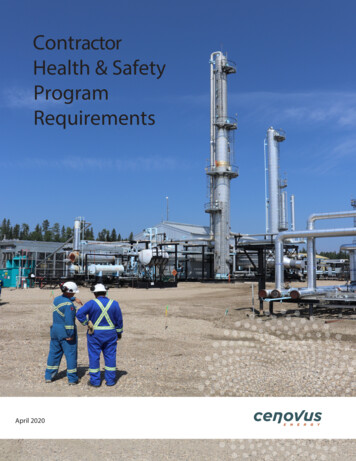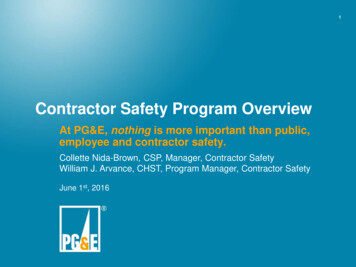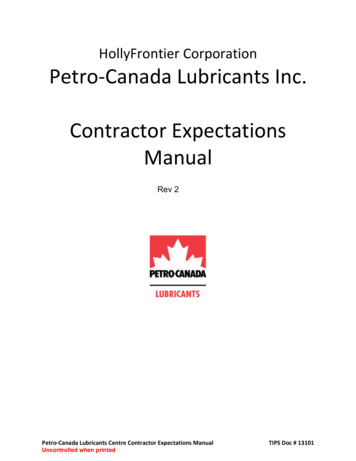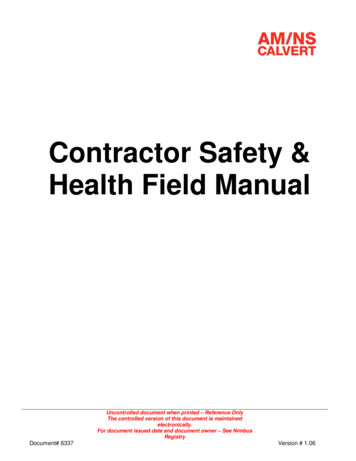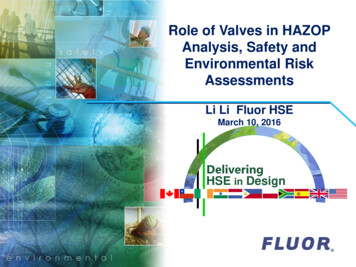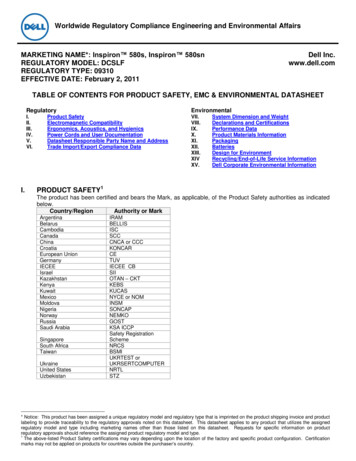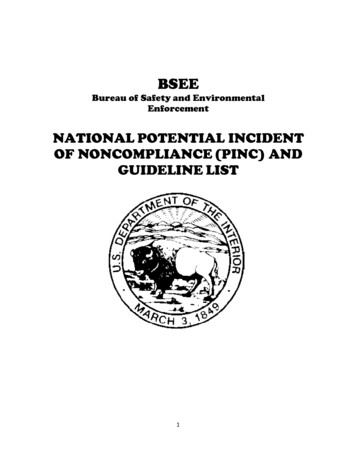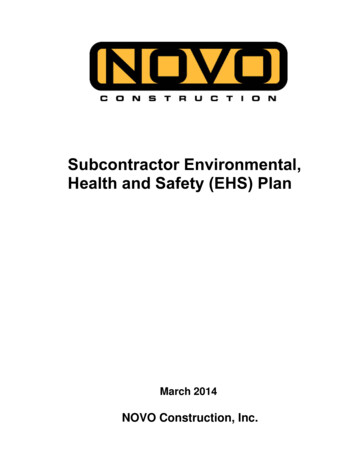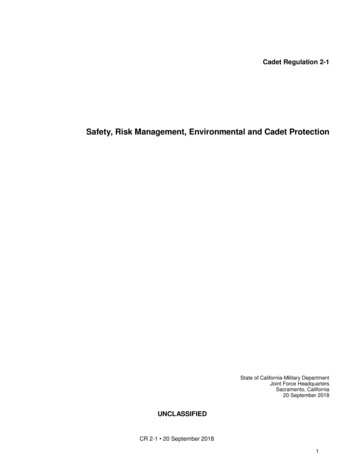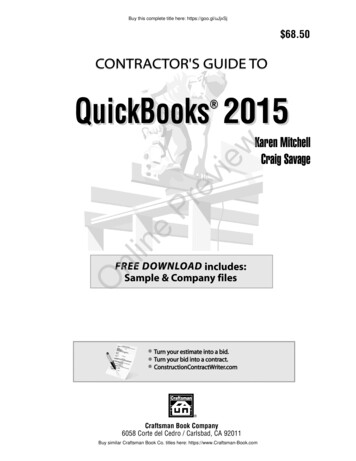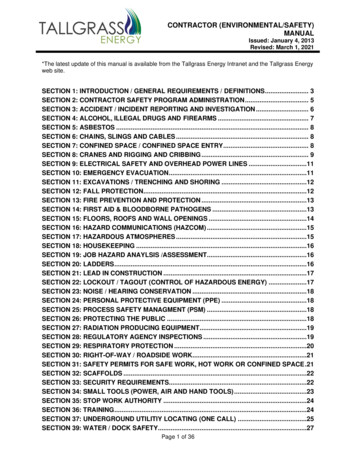
Transcription
CONTRACTOR (ENVIRONMENTAL/SAFETY)MANUALIssued: January 4, 2013Revised: March 1, 2021*The latest update of this manual is available from the Tallgrass Energy Intranet and the Tallgrass Energyweb site.SECTION 1: INTRODUCTION / GENERAL REQUIREMENTS / DEFINITIONS . 3SECTION 2: CONTRACTOR SAFETY PROGRAM ADMINISTRATION . 5SECTION 3: ACCIDENT / INCIDENT REPORTING AND INVESTIGATION . 6SECTION 4: ALCOHOL, ILLEGAL DRUGS AND FIREARMS . 7SECTION 5: ASBESTOS . 8SECTION 6: CHAINS, SLINGS AND CABLES . 8SECTION 7: CONFINED SPACE / CONFINED SPACE ENTRY . 8SECTION 8: CRANES AND RIGGING AND CRIBBING . 9SECTION 9: ELECTRICAL SAFETY AND OVERHEAD POWER LINES .11SECTION 10: EMERGENCY EVACUATION .11SECTION 11: EXCAVATIONS / TRENCHING AND SHORING .12SECTION 12: FALL PROTECTION.12SECTION 13: FIRE PREVENTION AND PROTECTION .13SECTION 14: FIRST AID & BLOODBORNE PATHOGENS .13SECTION 15: FLOORS, ROOFS AND WALL OPENINGS .14SECTION 16: HAZARD COMMUNICATIONS (HAZCOM) .15SECTION 17: HAZARDOUS ATMOSPHERES .15SECTION 18: HOUSEKEEPING .16SECTION 19: JOB HAZARD ANAYLSIS /ASSESSMENT.16SECTION 20: LADDERS .16SECTION 21: LEAD IN CONSTRUCTION .17SECTION 22: LOCKOUT / TAGOUT (CONTROL OF HAZARDOUS ENERGY) .17SECTION 23: NOISE / HEARING CONSERVATION .18SECTION 24: PERSONAL PROTECTIVE EQUIPMENT (PPE) .18SECTION 25: PROCESS SAFETY MANAGMENT (PSM) .18SECTION 26: PROTECTING THE PUBLIC .18SECTION 27: RADIATION PRODUCING EQUIPMENT .19SECTION 28: REGULATORY AGENCY INSPECTIONS .19SECTION 29: RESPIRATORY PROTECTION .20SECTION 30: RIGHT-OF-WAY / ROADSIDE WORK.21SECTION 31: SAFETY PERMITS FOR SAFE WORK, HOT WORK OR CONFINED SPACE .21SECTION 32: SCAFFOLDS .22SECTION 33: SECURITY REQUIREMENTS.22SECTION 34: SMALL TOOLS (POWER, AIR AND HAND TOOLS) .23SECTION 35: STOP WORK AUTHORITY .24SECTION 36: TRAINING .24SECTION 37: UNDERGROUND UTILITIY LOCATING (ONE CALL) .25SECTION 39: WATER / DOCK SAFETY.27Page 1 of 36
CONTRACTOR (ENVIRONMENTAL/SAFETY)MANUALIssued: January 4, 2013Revised: March 1, 2021SECTION 40: WELDING SAFETY .27SECTION 41: WORK CLOTHING .28SECTION 42: WORKSITE SAFETY .28SECTION 43: ENVIRONMENTAL REQUIREMENTS - GENERAL .28SECTION 44: ENVIRONMENTAL – HAZARDOUS WASTE MANAGEMENT .30SECTION 45: ENVIRONMENTAL – SPILL PREVENTION AND CONTROL .30SECTION 46: ENVIRONMENTAL – DISCHARGES TO STORMWATER CONVEYANCESYSTEMS.31SECTION 47: ENVIRONMENTAL – EROSION CONTROL .31SECTION 48: ENVIRONMENTAL – EXCAVATION ACTIVITIES IN ENVIRONMENTALLYRESTRICTED AREAS.31SECTION 49: ENVIRONMENTAL – OPEN BURNING.31SECTION 50: ENVIRONMENTAL – WORKING NEAR WATERBODIES AND WETLANDS .31SECTION 51: DOT – OPERATOR QUALIFICATION (OQ) .32SECTION 52: MEDIA GUIDELINES .33APPENDIX 1 – REGULATORY APPLICATIONS TO SECTIONSPage 2 of 36
CONTRACTOR (ENVIRONMENTAL/SAFETY)MANUALIssued: January 4, 2013Revised: March 1, 2021SECTION 1: INTRODUCTION / GENERAL REQUIREMENTS / DEFINITIONSTallgrass Energy (the Company) strives to maintain a safe and healthy workplace for Employees andContractors. Contractors must report any unsafe work or environmental conditions which has or couldhave an adverse impact to human health or the environment. Contractors are to ensure the health andsafety of their workers and any person likely to be affected by the workers actions. Contractors havethe right to know about hazards and the means used to control or eliminate the hazards. Contractorshave the right to participate in workplace safety activities and to refuse to work in an unsafe orenvironmentally detrimental condition.This document provides all Contractors with the minimum Environmental, Health and Safety (EHS)standards required while working on and/or adjacent to Company premises. Non-compliance withsafety and/or environmental requirements is treated the same as non-compliance with any contractprovision and may result in work stoppage or Contractor removal from the premises. Willful or repeatednon-compliance may result in Contractor dismissal and contract termination.The Company requires that Contractors: Meet all guidelines outlined in Section 2.1, Pre-Job Requirements, of this manual prior tocommencing any work on Company premises.Ensure all workers are at least 18 years of age.Contact a Company Representative before proceeding, if the standards in this manual are notclearly understood, or if situations arise which are not covered by this manual.No Conduit: The Contractor has signed a contract containing an obligation to not disclose to any thirdparty any confidential information regarding Company which Contractor has obtained or creates as aresult of performing the contract. Contractor shall review its contractual confidentiality obligation withits designated company representative and periodically inform workers and subcontractors of therequirements.Electronic copies of the Contractor Environmentalhttps://www.tallgrass.com/ on the Contractor Safety page./SafetyManualcan befoundatNOTE: Consultants, Engineering Support, Temporary Labor, Visitors used in an office settingand/or escorted on project premises for general observation tasks are required to receive ageneral site safety orientation documented on form Contractor Safety Program Form CSM-008– Visitor Safety Information or equivalent. The general site orientation includes elements suchas; emergency procedures, PPE requirements and muster point locations. The ContractorEnvironmental / Safety Manual, DVD or ISN requirements do not apply.NOTE: Unless otherwise specified by contract, contractors must supply all tools andequipment. Including but not limited to: portable monitoring equipment, safety equipment,communication tools, etc.REGULATORY REQUIREMENTS AND CONTRACTORS RESPONSIBILITIESContractor is responsible for complying with applicable Federal, State, and local EHS regulations.Contractor must also comply with the requirements listed in the Contractor Environmental / SafetyManual and Company policies and procedures that are applicable to the project SOW.The standards presented in this document are not an exhaustive list of all applicable requirements andregulations. As a general rule, if there is uncertainty over which legislation applies (i.e., Federal, State)comply with the most stringent requirement.Occupational Health and Safety Administration (OSHA) General Industry Standards (1910),Construction Standards (1926) and/or the Mine Safety and Health Act (MSHA) may apply dependingon the nature of the work.Regulatory references applicable to each section are located in the Appendix at the end of thisdocument. The Contractor, however, is ultimately responsible for determining regulatory applicabilityPage 3 of 36
CONTRACTOR (ENVIRONMENTAL/SAFETY)MANUALIssued: January 4, 2013Revised: March 1, 2021and assuring compliance.General Definitions / AcronymsASSEMBLY AREA: A pre-determined location in which to assemble and conduct a roll call in case ofan emergency evacuation.CDL: Commercial Drivers License. Defined within the Federal Motor Carrier Safety Regulations CMV:Commercial Motor Vehicle. Defined within the Federal Motor Carrier Safety RegulationsCOMPANY: Tallgrass Operations, LLC Inc., Tallgrass Operations, LLC Energy Partners, L.P. or one oftheir subsidiaries, affiliates and/or business units.COMPANY REPRESENTATIVE: Any person contracted or assigned to perform short or long-termworkplace inspections for the Company.COMPETENT PERSON: A competent person is one who has been trained and is authorized to identifyand implement prompt correct actions to mitigate work site hazards.CONTRACTOR: Any company or person contracted to perform short or long-term work for theCompany. References to contractor includes; contractor’s workers, sub-contractors and third-partyinspectors and consultants.CRIBBING / SKIDDING: Is a process of stacking wooden skids (made of hardwood) to form a sturdyplatform in which to secure pipeline joints.CSM Forms: Company forms are referenced within this document. Forms are identified as CSM-001through CSM-009. ALL APPLICABLE Safety Forms can be found on the Contractor Safety webpage athttps://www.tallgrass.com/.DOT: U.S. Department of TransportationHIRING MANAGER: Includes Project Manager (PM), Supervisor, Lead and / or Manager that isaccountable for applying knowledge, skills, tools, resources, and techniques to all project activities,ensuring that project results meet stakeholder needs and expectations. With input from the ProjectSponsor, the Project Team, and other stakeholders, the Hiring Manager maintains and controls alllogistics/mechanics related to project completion.NEAR MISS: An undesired event or a condition that, under slightly different circumstances, could haveresulted in injury, damage or other loss.NFPA: National Fire Protection AssociationPHMSA: Pipeline and Hazardous Materials Safety Administration.PREMISES: References to Premises includes company property, job site, job and worksite. Any realproperty on which Contractor will be working, whether owned by Company or not, including facilities,terminals, roads, parking lots, pipeline right-of-ways, common areas, compressor/pump station oroffices.REPORTABLE INCIDENT: Any act, incident, injury, occurrence, unwanted release of energy, unwantedrelease of product or near miss that is not considered a normal operating procedure and/or anoccurrence that results in worker injury or monetary loss.SOW: Scope of work: Includes the purpose of a Project and Project Definition to reduce and ultimatelyeliminate ambiguity. Scope planning will demonstrate clear, detailed communication among the projectstakeholders that results in a clearly defined project with little misinterpretation. Specific project tasks,critical dates, and quality control measures are identified during scope development and projectdefinition.WORK: Any and all services, acts, obligations, duties and responsibilities necessary to the successfulcompletion of the project assigned to or undertaken by Contractor under the Contract Documents,including the furnishing of all labor, services, materials, equipment and other incidentals.Page 4 of 36
CONTRACTOR (ENVIRONMENTAL/SAFETY)MANUALIssued: January 4, 2013Revised: March 1, 2021SECTION 2: CONTRACTOR SAFETY PROGRAM ADMINISTRATIONContractors are expected to read this manual and to comply with Company requirements. TheCompany retains the right to question Contractors regarding the content of this manual and to stopwork if Contractors are observed operating in disregard to EHS requirements.2.1 The Company updates this document and forms periodically. Contractors are advised to check theCompany website for the most current Contractor (Environmental / Safety) Manual and forms. TheCompany website is located at: https://www.tallgrass.com/.2.2 Contractor Safety Pre-Job RequirementsAll Contractors are required to participate in the Company’s Contractor Safety Evaluation Programby subscribing to ISNetworld (ISN) or have a Contractor Exemption / Variance Safety Evaluationcompleted and signed by the Company Hiring Manager.Each Contractor subscribing to ISN is required to enter safety statistics into ISN. This informationincludes, but is not limited to the following: US OSHA StatisticsUS EMR RatesSafety ProgramsThe Company requires the Contractor to have satisfactory statistical scores in the abovecategories prior to the contract award and must be maintained quarterly thereafter.It is the Company’s expectation that the Contractor’s status within the ISN database remainsatisfactory throughout the duration of the project. If at any time the Contractor’s status becomesunsatisfactory, the Contractor must work with the Company Hiring Manager to develop a plan forcorrecting deficiencies and timelines for completion.Contact information for ISN: https://www.isnetworld.com/The Company may audit the performance of the Contractor as the job progresses and/or uponcompletion conduct a Post-Job Evaluation. All joint or self assessments that are conducted mustbe documented with all action items addressed by the contractor. This may include periodicpremises reviews. ISN may be used to store assessment results conducted by or for the Company.Upon request by the Company, the Contractor will provide copies of their applicable procedures,plans and documentation, including but not limited to specific to training, inspections,assessments, permitting and incident reporting.2.3 Safety OrientationAfter the project is awarded and prior to the start of work, the Contractor and applicable Companyrepresentatives must participate in a Safety Orientation which includes: A review of the Company EHS requirements, site specific hazards, abnormal operatingconditions, emergency response, restricted areas, security, potential hazards that may beencountered, evacuation procedures, assembly areas, safety systems and contractor accessand parking requirements at the worksite. The Contractor is encouraged to ask questionsduring the orientation process.The orientation must be documented on form CSM-003 or equivalent. The Contractor mustensure that everyone that works on Company premises receives this orientation. Theorientation is required annually or when changes to Project Scope of Work (SOW) and/or tothe Contractor Environmental / Safety Manual occur.A copy of the completedorientation form will be kept by a Company representative and filed in the project job book.Contractor must be issued the Company’s current “Contractor Safety Orientation” sticker fortheir hardhats. The location of the Contractor Environmental / Safety Manual will be identifiedin the orientation.The Contractor must maintain a daily list of all on-site workers. All visitors to Company premisesPage 5 of 36
CONTRACTOR (ENVIRONMENTAL/SAFETY)MANUALIssued: January 4, 2013Revised: March 1, 2021must sign in each time they enter/leave. Visitors must not be granted entry without prior permissionof Contractor or Company Representatives.Contractor Safety Program Form CSM-006 – Contractors / Visitors Log may be utilized todocument the sign in / out requirement.2.4 Contractor Duties and ResponsibilitiesContractors must provide direct supervision of their subcontractors. The Contractor must have aSubcontractor Management Plan in place which has been approved through the ISN process. TheContractor may utilize form CSM-005 or equivalent to document evaluations of theirsubcontractors. The Contractor must submit the required subcontractor evaluation documentationto the Company Representative upon request.2.5 Disciplinary ActionIf any Contractor requires, requests or allows workers to work in or around unsafe conditions orviolates environmental permits or regulations, the Company may remove the Contractor or any ofits individual workers from Company premises. For example, immediate and permanent removalmay occur if any of the following activities are observed:A. Openly exhibits disregard, defiance, or disrespect for the safety programB. Falsifying documents or informationC. Participates in fighting, violence, threats of violence, theft, or destruction of propertyD. Violates established safety or environmental rules, regulations, procedures or codesE. Possesses weapons including but not limited to firearms or knives not typically used inconjunction with normal work tasks2.6 SITE/PROJECT HEALTH AND SAFETY PLANS (HASP)As determined by the Company, the Contractor may be required to develop a project specificHealth and Safety Plan (HASP). If required, the HASP must establish the EHS expectations forthe project, describe the key processes to be utilized during the project by the Contractor andassign areas of responsibility. Based on the detailed work plan, the Contractor must conduct aHazard Evaluation to identify hazards anticipated during the project and measures that will beimplemented to eliminate or control the hazards.The Contractor must include plans for changing conditions, revised SOW, or new information thatwill warrant modifications to the HASP. The original HASP and any modifications or changes mustbe submitted to the Company Representative for review prior to the start of work. Any revisions tothe HASP will be returned to the Contractor for discussion or implementation.SECTION 3: ACCIDENT / INCIDENT REPORTING AND INVESTIGATION3.1 Key Requirements3.1.1 The Contractor must immediately report all accidents/incidents and near misses to theCompany Representative. If required, the Contractor must notify the applicable regulatoryagency within the required reporting requirements.3.1.2 The Contractor must investigate all accidents/incidents that result in, or have the potentialto result in, injury or illness, property damage, process/product loss or harm to theenvironment. The investigative process must include the identification of root causes or causalfactors that contributed to the occurrence. The Contractor must determine the necessarycorrective actions and ensure closure/completion in tim
general site safety orientation documented on form Contractor Safety Program Form CSM-008 – Visitor Safety Information or equivalent. The general site orientation includes elements such as; emergency procedures, PPE requirements and muster point locations. The Contractor Environmental / Safety
